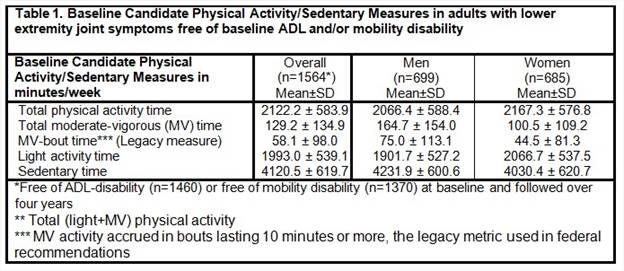Session Information
Date: Monday, October 22, 2018
Session Type: ACR Poster Session B
Session Time: 9:00AM-11:00AM
Background/Purpose: This study evaluated physical activity and sedentary times to identify an evidence-based threshold related to remaining free of disability over 4 years among adults with lower extremity joint symptoms.
Methods: Remaining free of disability over 4 years (i.e., no disability onset) was assessed from self-report of no limitations in activities of daily living (ADL-disability free) and objective gait speed ≥1 meter/second (mobility-disability free). Adults with symptomatic lower extremity (hip, knee, ankle, foot) joint pain/aching/stiffness who participated in an accelerometer substudy of the Osteoarthritis Initiative (OAI) included n=1564 ADL-disability free (n=1460) or mobility-disability free (n=1370) persons at baseline (OAI 48-month clinic visit). Optimal thresholds predicting 4-year disability-free status were assessed by maximum area under the receiver operating characteristic curve (AUC) and classification tree analysis.
Results: Over four years 84% (1222/1460) participants remained free of ADL-disability and 89% (1223/1370) remained free of mobility-disability. Figure 1 shows total MV activity per week was the strongest predictor of all Table 1 candidate measures based on the greatest AUC of remaining free of ADL-disability (AUC=0.61) and free of mobility-disability (AUC=0.80). Classification tree analyses selected total MV>55 minutes/week over all possible activity/sedentary candidate thresholds as the best discriminator between remaining free of versus developing ADL-disability and mobility-disability. Observed disability onset rates over four years were almost double (23% versus 12%) for developing ADL-disability and 8 times greater (24% versus 3%) for mobility-disability among persons below compared to those above this threshold. Meeting the 55 total MV minute/week threshold significantly increased the odds for remaining free of ADL-disability (odds ratio [OR]: 2.0, 95% CI: 1.5 to 2.7) and free of mobility disability (OR 8.6, 95% CI: 5.7 to 13.1). Thresholds were consistent across sex, BMI, age, and radiographic knee OA status.
Conclusion: Meeting an evidence-based threshold of at least 55 total MV minutes/week increased the likelihood of remaining free of both ADL-disability and mobility-disability over 4 years among adults with lower extremity joint symptoms. This evidence-based threshold supports future disability-free status and may help motivate sedentary adults with joint conditions to begin their path towards attaining the federal recommendation which promotes a wide range of health benefits.
To cite this abstract in AMA style:
Dunlop DD, Song J, Hootman JM, Lee J, Nevitt MC, Sharma L, Semanik P, Eaton CB, Kwoh CK, Hochberg MC, Jackson RD, Chang RW. Some Is Better Than None: Minimum Physical Activity Threshold to Prevent Disability in Older Adults with Lower Extremity Joint Symptoms [abstract]. Arthritis Rheumatol. 2018; 70 (suppl 9). https://acrabstracts.org/abstract/some-is-better-than-none-minimum-physical-activity-threshold-to-prevent-disability-in-older-adults-with-lower-extremity-joint-symptoms/. Accessed .« Back to 2018 ACR/ARHP Annual Meeting
ACR Meeting Abstracts - https://acrabstracts.org/abstract/some-is-better-than-none-minimum-physical-activity-threshold-to-prevent-disability-in-older-adults-with-lower-extremity-joint-symptoms/


